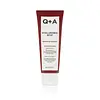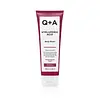What's inside
What's inside
 Key Ingredients
Key Ingredients

 Benefits
Benefits

 Concerns
Concerns

 Ingredients Side-by-side
Ingredients Side-by-side

Water
Skin ConditioningCoco-Betaine
CleansingGlycerin
HumectantPropanediol
SolventCaprylyl/Capryl Glucoside
CleansingAcrylates/C10-30 Alkyl Acrylate Crosspolymer
Emulsion StabilisingSodium Hyaluronate
HumectantSodium Gluconate
Skin ConditioningAloe Barbadensis Leaf Juice Powder
Skin ConditioningCaprylyl Glycol
EmollientPhenoxyethanol
PreservativeSodium Hydroxide
BufferingCocamidopropyl Betaine
CleansingWater
Skin ConditioningSodium Coco-Sulfate
CleansingCocamidopropyl Betaine
CleansingLauryl Glucoside
CleansingCaprylyl/Capryl Glucoside
CleansingGlycerin
HumectantHyaluronic Acid
HumectantAloe Barbadensis Leaf Juice
Skin ConditioningSodium Hyaluronate
HumectantSaccharide Isomerate
HumectantMacrocystis Pyrifera Extract
Skin ConditioningLonicera Caprifolium Flower Extract
PerfumingLonicera Japonica Flower Extract
Skin ConditioningSodium Gluconate
Skin ConditioningSodium Benzoate
MaskingPotassium Sorbate
PreservativeSodium Citrate
BufferingGuar Hydroxypropyltrimonium Chloride
Skin ConditioningGlycol Distearate
EmollientLaureth-4
EmulsifyingParfum
MaskingSodium Chloride
MaskingCitric Acid
BufferingLinalool
PerfumingWater, Sodium Coco-Sulfate, Cocamidopropyl Betaine, Lauryl Glucoside, Caprylyl/Capryl Glucoside, Glycerin, Hyaluronic Acid, Aloe Barbadensis Leaf Juice, Sodium Hyaluronate, Saccharide Isomerate, Macrocystis Pyrifera Extract, Lonicera Caprifolium Flower Extract, Lonicera Japonica Flower Extract, Sodium Gluconate, Sodium Benzoate, Potassium Sorbate, Sodium Citrate, Guar Hydroxypropyltrimonium Chloride, Glycol Distearate, Laureth-4, Parfum, Sodium Chloride, Citric Acid, Linalool
 Reviews
Reviews

Ingredients Explained
These ingredients are found in both products.
Ingredients higher up in an ingredient list are typically present in a larger amount.
Caprylyl/Capryl Glucoside is an alkyl glucoside. This just means it is creating by reacting alcohol and sugar. It is a cleansing and foaming ingredient.
Caprylyl/Capryl Glucoside helps remove the dirt, oil, and other pollutants from your skin.
Cocamidopropyl Betaine is a fatty acid created by mixing similar compounds in coconut oil and dimethylaminopropylamine, a compound with two amino groups.
This ingredient is a surfactant and cleanser. It helps gather the dirt, pollutants, and other impurities in your skin to be washed away. It also helps thicken a product and make the texture more creamy.
Being created from coconut oil means Cocamidopropyl Betaine is hydrating for the skin.
While Cocamidopropyl Betaine was believed to be an allergen, a study from 2012 disproved this. It found two compounds in unpure Cocamidopropyl Betaine to be the irritants: aminoamide and 3-dimethylaminopropylamine. High-grade and pure Cocamidopropyl Betaine did not induce allergic reactions during this study.
Learn more about Cocamidopropyl BetaineGlycerin is already naturally found in your skin. It helps moisturize and protect your skin.
A study from 2016 found glycerin to be more effective as a humectant than AHAs and hyaluronic acid.
As a humectant, it helps the skin stay hydrated by pulling moisture to your skin. The low molecular weight of glycerin allows it to pull moisture into the deeper layers of your skin.
Hydrated skin improves your skin barrier; Your skin barrier helps protect against irritants and bacteria.
Glycerin has also been found to have antimicrobial and antiviral properties. Due to these properties, glycerin is often used in wound and burn treatments.
In cosmetics, glycerin is usually derived from plants such as soybean or palm. However, it can also be sourced from animals, such as tallow or animal fat.
This ingredient is organic, colorless, odorless, and non-toxic.
Glycerin is the name for this ingredient in American English. British English uses Glycerol/Glycerine.
Learn more about GlycerinThis is the synthetic salt of gluconic acid, a form of PHA and mild exfoliant.
It is mainly used to stabilize oil and butter formulations from going bad. Sodium gluconate is a humectant, pH regulator, and chelating agent.
Chelating agents help neutralize unwanted metals from affecting the formulation.
Sodium gluconate is water-soluble.
Learn more about Sodium GluconateSodium Hyaluronate is hyaluronic acid's salt form. It is commonly derived from the sodium salt of hyaluronic acid.
Like hyaluronic acid, it is great at holding water and acts as a humectant. This makes it a great skin hydrating ingredient.
Sodium Hyaluronate is naturally occurring in our bodies and is mostly found in eye fluid and joints.
These are some other common types of Hyaluronic Acid:
Learn more about Sodium HyaluronateWater. It's the most common cosmetic ingredient of all. You'll usually see it at the top of ingredient lists, meaning that it makes up the largest part of the product.
So why is it so popular? Water most often acts as a solvent - this means that it helps dissolve other ingredients into the formulation.
You'll also recognize water as that liquid we all need to stay alive. If you see this, drink a glass of water. Stay hydrated!
Learn more about Water